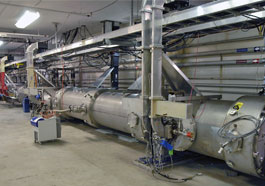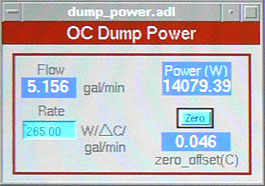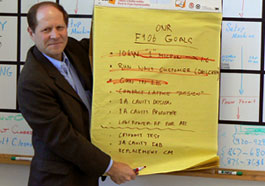
The linear accelerator portion of the FEL.
On Thursday, Oct. 26, Free-Electron Laser (FEL) team members knew they were within reach of a goal they'd pursued for two years. They were aiming to produce 10 kW of laser light at an infrared wavelength of 1.61 microns. On that day, they blew past the milestone to produce 11.7 kW.
But the team didn't stop there. They pushed the machine they had spent years designing, crafting and tweaking to surpass the record they had just set. On Monday, Oct. 30, just four days later, they coaxed another two kW out of the machine shoving the record even higher at 14.2 kW.
A Short History
The FEL program began as the One-Kilowatt Demonstration FEL, which broke power records and made its mark as the world's brightest tunable, high-average power laser. It delivered 2.1 kilowatts (kW) of infrared light, more than twice the level it was initially designed to achieve, before it was taken offline in November 2001 for an upgrade to 10 kW.
The FEL team originally attained the 10 kW milestone in July 2004 at an infrared wavelength of 6 micrometers (microns, for short). Then the FEL's primary funding agency, the Office of Naval Research, charged the team to repeat the record at a much shorter wavelength: 1.6 microns. Still in the infrared, this wavelength of light is the least dangerous to eyes in this part of the light spectrum, while also theoretically capable of effectively piercing humid atmospheres, a necessity for the Navy's goal of building a ship-based laser capable of protecting its ships from incoming missiles. In addition, the wavelength is of interest for exploring a wide range of applications, including defense and manufacturing technologies and scientific studies in chemistry, physics, biology and medicine.
How It Works
The Free-Electron Laser (FEL) provides intense beams of laser light that can be tuned to a precise wavelength. Conventional lasers are limited in the wavelength of light they emit by the source of the electrons (such as a gas or crystal) used within the laser. In the FEL, electrons are stripped from their atoms and whipped up to high energies by a linear accelerator. From there, they are steered into a wiggler, a device that uses magnetic fields to shake the electrons, forcing them to release some of their energy in the form of photons. As in a conventional laser, the photons bounce between two mirrors and are then emitted as a coherent beam of light. FEL operators can adjust the wavelength of the laser's emitted light by increasing or decreasing the energies of the electrons in the accelerator or the amount of shaking in the wiggler.
In 2004, after running a few experiments at 6 microns and still fresh from its 10 kW triumph, the FEL group, led by the FEL Physics Performance Team, partially dismantled the machine to upgrade it again to set another record at 10 kW. Along the way, the team overcame many new challenges, but the toughest were clearing a block of frozen air that blocked one of the acceleration modules, installing a highly efficient wiggler optimized for the 1.61 micron infrared wavelength and developing a groundbreaking set of new mirrors that can withstand the intense laser light.
Snowballs, Wigglers and Mirrors, Oh My!
They call it the snowball. It appeared on the last Friday in February 2005 inside the "Admiral," the FEL's newest cryomodule which had been installed the previous year (see "How it Works" diagram, right). The Admiral contains eight niobium cavities for accelerating the electrons through a path at its center. This path was plugged with a solid block of frozen air.
Cryomodules are kept at a frigid 456 degrees Fahrenheit below zero and under vacuum, meaning that all the stuff you ordinarily find in air, like humidity, dust and nitrogen and oxygen gas, has been removed. Somehow, one of the Admiral's windows had cracked. Since there was nothing to leak out, air leaked in. "We knew something was blocking the beam," says Dave Douglas, the FEL accelerator physics specialist on the on the FEL Physics Performance Team. It didn't take the team long to find the problem. "We couldn't run an electron beam through the accelerator, because the accelerator was clogged up with a giant snowball."
The Jefferson Lab team that built the cryomodule quickly devised a plan to fix the Admiral. They draped thick sheets of heavy plastic around it, forming a mini clean room. The damaged window was replaced, and dry nitrogen was pumped through the cryomodule to clean out any contamination. When they had finished, they had set a new milestone in accelerator physics: for the first time at JLab, a superconducting radiofrequency cryomodule had been extensively repaired while still installed in an accelerator. "We did absolutely the worst thing you could do to kill the machine, and then we brought it back," Douglas says.

A snapshot of a FEL control room computer screen showing the laser output power as the team pushes the laser toward 14 kW. Here, the machine is delivering 14.079 kW of infrared laser light at 1.61 microns.
The Admiral doesn't perform as well as it did before the window cracked, limiting the energy the team can stuff into its electron beam. But the FEL team has managed to make up for that in other areas, including increasing the current by essentially putting more electrons into each electron bunch sent through the machine and by increasing the machine's efficiency.
The next challenge that faced the team came in the form of a new wiggler. It was determined that the electromagnetic wiggler that brought the machine to 10 kW the first time was not optimum for the shorter wavelength. The team procured and installed a new electromagnetic wiggler but found it still wasn't what the team needed. Â
In late fall of 2005, the newer electromagnetic wiggler was replaced with a permanent magnet wiggler. To change the wavelength of the photons now, the team need only change the gap between the regular magnets that comprise the wiggler. This wiggler was optimized for the 1-2 micron wavelength range. With a set of serious calculations and a few tweaks to the accelerator, it, too, was optimized for providing electrons to the wiggler in the very compact bunches needed for a good laser beam.

Goals met! Fred Dylla displays a running tally of the FEL team's progress.
The last item on the list was a new set of mirrors. Located on either end of the wiggler, the mirrors constitute the optical cavity and must be able to withstand 70 kW of light from the photons bouncing between them when the machine is producing a 14.2 kW beam of laser light. Designing the mirrors was no small task, says Michelle Shinn, the FEL optics specialist on the FEL Physics Performance Team.
"No one else is in a position to run the optics at the energy we're going to run them at," she says, "So no one else can test to see if they'll work before we put them in the machine."
Shinn calculated the best formulation for the mirrors and sent the specifications off for manufacturing. Several sets of mirrors were fabricated before a set was made that reached all of the initial specifications. A new cooled mirror technique was also implemented to keep the mirrors from heating up and warping from the intense heat carried by the infrared photons.
Looking to the Future
"Right now, we can produce five or six kilowatts of infrared light all day if we need to, without any problems. At 10 kilowatts or better, we can function reliably for an hour, before we begin seeing any major glitches," says Steve Benson, the FEL physics specialist on the FEL Physics Performance Team. Benson says the group's goal now is to stabilize the laser at higher energies and begin exploring its capabilities at other infrared wavelengths at lower powers.
"In the one kilowatt range, the FEL has broad tunability. We can tune it to produce infrared light between .7 and 4.5 micrometers," says Fred Dylla, Associate Director of the FEL Division and JLab Chief Technology Officer. "Sometime in the near future, we're going to explore how far we can tune the wavelength."
There are also a wide range of experimenters seeking to access the FEL's high power capabilities. The highest priority goes to the Office of Naval Research, which provided most of the FEL's funding and galvanized the push to 10 kW at the 1.61 micron wavelength. “This wavelength is of interest for material science applications and for naval interest in transmission of light through the maritime atmosphere,†Dylla says.
Other experimenters are ready to take advantage of a byproduct of the FEL's accelerator: Terahertz (THz) light. The FEL produces copious amounts of THz light and now has a dedicated lab to its study. Also known as t-rays, THz light has a wavelength between 3 millimeters and .003 millimeters. Although just about everything in the universe emits them, we can neither see nor feel these ubiquitous t-rays. T-rays may provide stunning breakthroughs in areas as diverse as national security, medical imaging and communications technology.
The Free-Electron Laser program is part of the Free-Electron Laser/Chief Technology Officer Division. It is supported in part by the Department of Defense’s Office of Naval Research, the Naval Sea Systems Command, the Air Force Research Laboratory and the Joint Technology Office; and by the Commonwealth of Virginia.
More information:

This picture of the FEL team was snapped just after they achieved the first 10 kW milestone.

